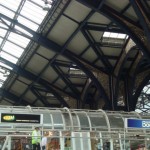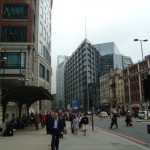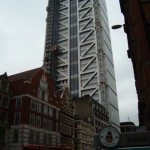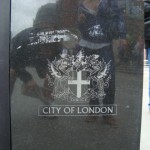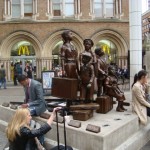Entries Tagged as '2010 Mary'
September 21st, 2010 · No Comments
As I read George Orwell’s article, I became increasingly interested in where this charming pub, The Moon Under Water, could be found. I will admit I was disheartened when I learned the pub did not actually exist. Nevertheless, I came to understand Orwell and his inability to find his “perfect” pub. I haven’t had extensive experience with pubs here in London, but after evaluating the ones I have visited, I can say I haven’t yet found my favourite pub either.
In regards to the location of the pubs, I have ventured into both the obvious pubs positioned glaringly on busy main streets and the more inconspicuous pubs situated off the beaten path in quieter areas. Like Orwell, my ideal pub is located on a side street where “drunks and rowdies [will] never seem to find their way” (The Moon Under Water, Orwell). The Marlborough Arms, which is just around the corner from the Arran House, is a local sort of pub that offers the intimate atmosphere where a mix of university students and middle-aged regulars can enjoy some privacy as they socialize over a few drinks. The bartenders are friendly (they offered a friend a free drink since her food arrived late) and the owner is also good-humored and amicable.

The Marlborough Arms Pub on Torrington Place, off of Gower Street
The clientele of a pub is also a significant factor in finding a great pub. There are pubs that seem to attract younger crowds, like The Court on Tottenham Court Road. It appeals to young adults mainly because of their young, attractive bartenders, booming beats, and prominent location. It’s a fun setting if you’re in the mood to deal with a jam-packed, noisy pub. Honestly, it reminds me more of a college party scene than anything else. I don’t want to find a number of other American students at the same pub! Another sort of clientele I’ve noticed some pubs gear toward is a tourist. The Rising Sun, also on Tottenham Court, does not seem to follow the normal English pub rules. Their staff seems to have adapted to serving foreigners since, for one, they have waiters who will cater to you as you sit at a table. I prefer the traditional English pub experience where one must go up to the bar to buy food, a round, or to discreetly tip the bartender—just as Kate Fox explains in Watching the English.
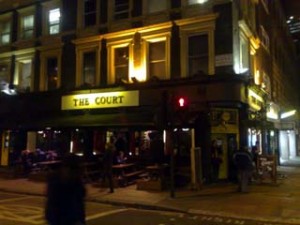
The Court Pub on Tottenham Court Road
Another topic Orwell brings up in regards to pubs is the selection of food and drinks. Unfortunately, I have not come across a pub that combines great food and drinks with my ideal pub environment. The ambience at the Marlborough Arms is great—decent music, some noise, a match playing on the telly, friendly patrons, some privacy and comfort—, but the food is mediocre, in my opinion. Moreover, I have had better drinks served elsewhere. Like, for example, the great menu at The Cock a few blocks off of Oxford Street. I agree with Orwell that the quality of food is important for a pub. Superior food and a good selection of drinks add to its comfort and distinctiveness.
Speaking of distinctiveness, I also think it’s important that a pub distinguishes itself from other pubs. As Orwell stated, he enjoys pubs with gardens and he only knows of three that possess them. Moreover, he covers in detail the architectural layout of his ideal pub, The Moon Under Water. Not that I have discovered my preferred “look” of a pub, I have recognized that I like pubs that express some sort of distinction from the rest. My ideal pub should definitely stand out. It could attain this through its architecture, its garden, or even just its quirky name, like The Moon Under Water.

The Old Bank of England Pub on Fleet Street
Sure, I hope to sometime pick a favourite pub, but I also don’t mind exploring all sorts of pubs and their disparate clientele, atmospheres, food and drink selections, patrons, and quirks. In the end, each pub is different; I just have yet to find that one “great” pub. It’s not The Old Bank of England Pub on Fleet Street—a high-class pub near the legal courts that had potential to be the favourite—so maybe I will stumble upon it in Norwich.
Tags: 2010 Mary · Pubs
September 19th, 2010 · No Comments
Hailing from a small New England town tucked away in the white mountains of New Hampshire, I’m quite familiar with “green space.” I am actually more unaccustomed to living anywhere even close to a big city. Nearest to home is Boston—a two hour and fifteen minute haul. Therefore, one significant change in living in London is the disappearance of the monstrous mountains, endless trees, and, of course, fresh, crisp air. However, this wondrous city never ceases to surprise me. The parks I have visited are, as many can agree, blessed sanctuaries. I unintentionally have separated the innumerable parks into two groups: the larger, well known ones and the smaller, more secluded ones. Each sort of park provides a different environment.
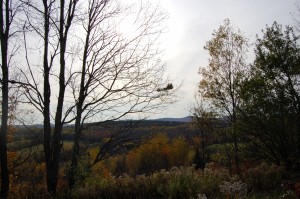
New England’s expansive green space (personal photo)
Of the “royal” parks (they’re labeled as such on London’s website) I have enjoyed Hyde Park and its nearby neighbor, Kensington Gardens; the Green Park, St. James’s Park, and the Reagent’s Park. It is at times entertaining to get lost in these massive parks. As a person wanders, he or she delves deeper into the green refuge and furthers him or herself from the city’s bustle and grime. I enjoyed exploring the incalculable monuments, memorials, and museums that materialize in these sprawling parks. These sanctuaries are not just for people to escape the city chaos; they serve as a safe place to preserve the surrounding area’s detailed history. I researched Hyde Park extensively and the pride the Londoners hold for the history of the park and the area itself is immediately evident. Speaker’s Corner, Rotten Row, Serpentine, the Wellington Museum—they all are housed within Hyde Park to be preserved and honored. For one, Hyde Park Corner Tube Station boasts tunnels decorated with elaborate murals illustrating the area’s history. How that for an introduction?

Hyde Park
The smaller parks have their own benefits. Scattered throughout the city and hidden in unexpected areas of London, these parks also present its community with an opportunity to take a break from the stresses of life. Although, they seem to enact stricter regulations, the parks offer a one with a place for relaxation, tranquility, entertainment, and community. Not to say these features do not apply to the larger parks, but these small parks seem much more intimate and more closely connected to the residents of the area. Also, these parks oftentimes possess a number of historical monuments but to a lesser degree in comparison to the royal parks. Even so, all of these parks in London, regardless of their size, give people a place to take a break from city life or just life in general. And to me, I particularly like that each one prides itself on its distinctive, detailed history.

Bedford Square, the park just down Gower Street
Tags: 2010 Mary
September 18th, 2010 · 1 Comment

All My Sons Poster for the Apollo Theatre
On Thursday evening I went to see Arthur Miller’s play All My Sons at the Apollo Theatre. Not to boast too much—I’m sure most people are tired of hearing about it—but three others and I purchased box seats in the theatre for only £10 each. We had to wake up early to queue for two hours in the bitter cold before the box office opened at 10am. It was definitely well worth feeling frozen for the rest of the day in order to see the play that evening.
I’m familiar with two of Arthur Miller’s other plays, Death of a Salesman and The Crucible, but knew nothing whatsoever about All My Sons. The play itself was very enjoyable—natural, uncomplicated lines presented by seemingly simple characters. Without examining the acting itself, the play’s deeper meanings and the presentation and development of them was brilliant. However, I’m no qualified theatre critic, so I’ll stick to sharing my reaction to the adaptation I saw.
The Apollo Theatre itself is a “Grade II listed West End Theatre, on Shaftesbury Avenue in the City of Westminster” and was built in 1901 (cited in above link). It’s a traditional theatre in that it has a large main stage with a cozy gallery of seats located on its ground floor, two upper balconies and side box seats. The audience for Thursday’s performance was mature. I would say most of the viewers were in their sixties. Us four Dickinsonians were definitely the youngest box seat ticket holders. The playwright Arthur Miller was, after all, very popular throughout the 1940s, ‘50s, and early ‘60s, so the maturity of the audience made sense.
In regards to where I sat in the theatre, the box felt like it was almost hovering over the stage. My view was somewhat restricted, but never before did I have the opportunity to see the actors’ facial expressions and gesticulations in such detail! Moreover, the setting—which included a real grass floor, an abundance of vegetation, and the front of a country house—could also be seen in great detail. Altogether, I was able to watch an incredible play and truly be a part of the scene.
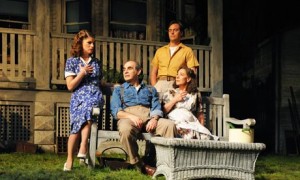
Main cast members of Arthur Miller’s Play
In All My Sons I was blown away by the two main actors’ performances. David Suchet’s reenactment of Joe and Zoë Wanamaker’s interpretation of Kate were absolutely extraordinary. For one, Suchet portrayed Joe’s sudden emotional changes flawlessly and with ease. One moment he could be furious, the mood convincingly illustrated in every corporeal and facial expression, and suddenly he would become vulnerable and distraught with tears streaming down his face. To me, the only negative aspects of the show were: the supporting cast’s American accents slipping at times (something I actually found amusing) and the set’s peculiar depiction of the Ohio countryside as looking more like the Louisiana bayou.
In the end though, All My Sons far exceeded the other theatre productions I’ve seen in London. Shakespeare’s Merry Wives of Windsor is still a favourite, especially since it was my first experience in the Globe Theatre. Bedlam, also in the Globe, was enjoyable only because of the jokes I shared with fellow classmates afterwards. I did love Les Misérables with its brilliant lighting, impressive set design, and Éponine’s angelic voice, but I wasn’t blown away by the performance (it did not help that my seat was in the uppermost balcony). 39 Steps was innovative and entertaining, but I found the slapstick humour dull after a while. The Habit of Art forced me to consider deeper, more intellectual ideas but was not the most well written play, I think. All in all, I have thoroughly enjoyed my theatre experience in London—although I would love to see some dance while I’m still here in England—and have appreciated every play and musical I have seen thus far.
If you haven’t see All My Sons yet, please do, and share your thoughts!
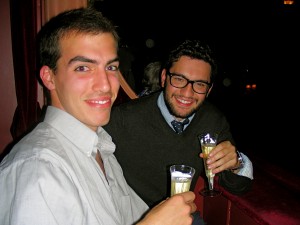
Patrick and Matt at the play All My Sons (personal photo)
Tags: 2010 Mary · Theatre
September 15th, 2010 · 2 Comments
Unless you have previous knowledge of the museum beforehand, the John Soane Museum will initially confuse you. Expecting to see another massive and imposing building, the Soane Museum is actually just an inconspicuous house located amidst the London city chaos. Without much of an introduction, I wandered inside holding my purse in a clear plastic bag—the reason for which I learned later on—immediately into Sir John Soane’s past. I wandered through the intricate maze of tall and narrow doorways and winding staircases, coming across only a small number of plaques describing Soane and his belongings. I gradually learned he was an English architect, remembered most for his remarkable skill and his design of the Bank of England.
John Soane’s house was incredible. The detail in the architecture was intricate and the colors and designs were nuanced and distinct. Besides the building itself, the objects it housed seemed for the most part entirely out of place. For example, a large open room, extending from a stone basement to a glass roof, exhibits a myriad of ancient Greek stone architectural pieces. Apparently the room is intended for students to wander through feeling as if in Greece while learning about the architecture. Although I appreciated the museum by the end of my personal tour, I could compare it to another museum I visited in Boston and did not enjoy it nearly as much.
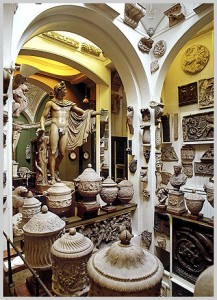
Greek Architecture Exhibit, John Soane Museum
The Isabella Stewart Gardner Museum in Boston, Massachusetts is similar to the John Soane Museum in that it’s a personal home that displays the past owner’s invaluable possessions. Isabella Gardner was not an architect like Soane, but rather a remarkable art collector, patron of the arts, and philanthropist. Unlike the Soane Museum, the Gardner Museum offered a tour as soon as the visitor entered—something vital when there’s an apparent lack of plaques, brochures, and audio guides. Furthermore, the organization and presentation of the pieces in the Gardner Museum was more effective. Instead of a disorganized jumble, Gardner’s rooms centralized the visitors’ focus on one main piece and designed the rest of the art in the room to reflect and elaborate on the piece’s expression. For example, one room displays a striking, passionate sort of painting, while other sculptures, drawings, plants, and the room’s decoration further emulate the painting’s dark, mysterious emotions.

Painting in Isabella Stewart Gardner Museum
In the end, I enjoyed the John Soane Museum as an exploration of one man’s architectural talent and creativity, the rare objects he collected, and his life in 18th and 19th century England. However, it became a challenge when I compared it to another somewhat similar museum that I much preferred over the Soane.
Tags: 2010 Mary · Museums
September 14th, 2010 · 4 Comments
The other day I went with a few others to the Newman House up the road from Arran House to attend Catholic mass. On the whole I think we all enjoyed the experience and actually gained a lot from it. For me, it was a relief to finally hear a native Englishman discuss the role of Catholicism in England, a topic I’ve been curious about even before coming to London.
Briefly looking around at the number of university students congregated in the small chapel, the priest quickly recognized that most were foreign to England. I could not tell whether or not his decision to touch on prominent hot button religious issues was planned. Regardless, the priest took advantage of preaching to the variety of students about contraceptives, abortion, homosexuality, and the global fear of Catholicism. Obviously they’re quite heavy, controversial issues to discuss in just a twenty-minute sermon.
Although the priest’s explanation of the Catholic Church’s view regarding homosexuality was particularly intriguing—and positive—, I was most interested in his discussion regarding the presence of Catholicism in England. He described the underlying sense of fear of Catholicism and the Papacy among the English. The priest made comments alluding to the English people’s standoffishness toward practicing Catholics and the Church on the whole. The discord among Anglicans and English Catholics apparent today may be incomparable to the country’s history but the unease among the English is still faintly visible. The priest at one point joked that the English fear the Papacy in Rome and devout Spanish Catholics will some day return to England to convert everyone back to Catholicism.
From my experience touring Westminster Abbey, St. Paul’s Cathedral, a Hindu mandir, Jewish synagogue, and Islamic mosque, and attending Catholic mass in a small university chapel, I have realized a subtle controversial religious dialogue materializing in London. England has an established church but their reaction to religious diversity is much different from America’s where no church is established. There is a fear of Catholics worldwide, but where I live the religion is thriving and accepted (again, that could easily be just because of my location in the northeast). I think religion is part of an American’s cultural identity but also one’s spiritual faith is more strongly expressed, whereas in England, Anglicanism easily becomes just a label. As Kate Fox described: a child once asked their parent what their religious background was, and the parent told the child to mark Anglican. When the child questioned this decision, the parent stated that that’s just what one was supposed to put. Furthermore, as the gentleman at the synagogue explained today, it would be unwise for a candidate for Prime Minister to publically share their religious beliefs, whereas in the United States, a politician’s religious devotion is widely broadcast. Although both nations continue to struggle with religious tolerance and freedom, I would say I feel more comfortable as Catholic in America than in England. I receive opposition in America, but I also feel free to defend my beliefs. Here in England, even people’s spiritual devotion to the established church is diminishing; completely ignoring the fact that Catholicism’s presence is seemingly minimal. Although my experience at the Newman House was most definitely positive, I look forward to finding a larger community of Catholic students at UEA in Norwich (hopefully).
Tags: 2010 Mary · Churches and Cathedrals
September 9th, 2010 · 6 Comments
Of all people in our Humanities Program, I may have had the most difficulty with adapting to the rules of the road in England. Now whether or not this is because I come from a small town in New Hampshire, I seem to be making a habit of nearly getting into a car accident almost daily. Despite the possibility that I could just be oblivious or thoughtless when crossing the street, I would rather not focus on that contentious topic. Instead I will take the time to compare the driving methods I have experienced in the U.S., specifically in New Hampshire, to London, England.
New Hampshire strictly follows the written law of stopping for all pedestrians in crosswalks. If caught breaking this law, the driver will receive a hefty fine. In regards to customary rules of the road though, to a large extent pedestrians and cyclists rule the road in New Hampshire. Even when pedestrians jaywalk and stroll across the street blissfully unaware of any possible danger, vehicles will stop (at least try to, let’s say). Additionally, in my small hometown of Hanover there is little road rage toward pedestrians and cyclists.
In regards to London though, the driving rules differ entirely. Of course it was a challenge adapting to looking left instead of right when crossing the road, but that was only an initial problem. Over these past two weeks, I have witnessed several drivers ignore red lights and many do not use their turn signals. This is not to say that there is a complete disregard for the written law though. It just seems that English people emphasize the observance of unwritten and widely accepted road rules instead. One significant principle is that it is the motorists and not the pedestrians who manage the traffic. Unless permitted to walk in the zebra crossing (crosswalk), people must remain on the sidewalk. I have learned that vehicles will maintain their speed if you try to bravely venture out into the road without heeding the walk signal. Furthermore, motorcyclists will rev their engines as soon as the traffic light turns green, ignoring the pedestrians attempting to cross the street at the last minute.
All in all, when in doubt—and when in London—follow this rule: “green man means go, red man means no.” The “green man” and “red man” of course refer to the walk signals for street crossing.
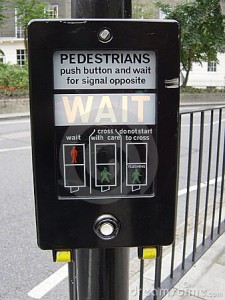
Walk Signal in England
In response to this blog, I would like to hear other people’s experiences with interacting with drivers in London, as well as their understanding of road rules at home in the United States.
Tags: 2010 Mary

“Eve” by Thomas Brock, 1899
Seeing the Victoria and Albert Museum is a must. And you most definitely should enter the museum via the Tube entrance. Prior to my visit, I naïvely believed the Victoria and Albert Museum would display art from Queen Victoria’s reign to illustrate the period—I found myself mistaken. Upon entering V&A from the underground tunnel, I immediately stepped foot into a series of small, dark rooms off to the right. The rooms modestly displayed furniture and tapestries from Europe dating from the seventeenth to nineteenth century. I then wandered into the main museum hallway above ground and explored the diverse assortment of sculptures extending down a long hallway. Taken aback, I quickly realized the V&A actually displayed a much broader range of art. By the end of my visit, I found that was a huge understatement. The Victoria and Albert Museum is enormous and houses a collection of almost every type of visual art.
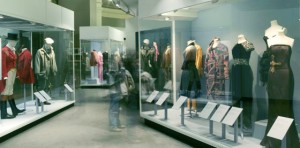
Fashion Exhibit
The museum map became somewhat useless and rather bothersome as I wandered through the labyrinth of art. Branching off of the main sculpture room—which included work from a favorite sculptor of mine, Rodin—were displays of art from China, the Islamic Middle East, Japan, Korea, South Asia, and South-East Asia. Another room I thoroughly enjoyed was a room presenting fashions from Italy, the United States, Japan, England, and France. The clothing dated from the eighteenth century through today. I only explored parts of the first floor and I still had five more levels!
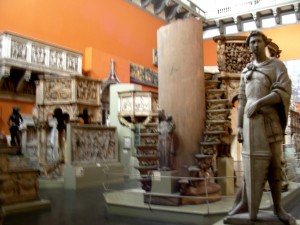
Plaster-casted Sculpture Exhibit (personal photo)
Throughout the remainder of my museum tour, I discovered collections of photography, mini architecture models, prints, drawings, paintings, tapestries, sacred silver and gold, and stained glass. There were also two massive rooms of plaster-casted architecture and sculptures dating from the eighteenth century, when plaster-casting famous works was popular for museum displays. Numerous rooms displayed eclectic exhibits of Medieval and Renaissance European art from the fourth to seventeenth century. When I finally stumbled into a dark hidden room of priceless jewelry dating back from 1500 BC, I was irrevocably astounded. I was lost in the Victoria and Albert museum but when discovering all these sorts of extraordinary pieces of art, who didn’t want to be?

Stained-glass Exhibit (personal photo)
On the whole, the museum’s collection was incredible (if that’s not obvious already). I was completely taken aback by the wide array of art displayed, as well as the priceless items included—countless pieces of silver and jewelry, as well as Leonardo da Vinci’s notebooks and Raphael’s paintings (coming soon). However, the organization of the museum is a contentious topic. The pieces of art come from all over the globe and date back to 1500 BC. Also, obviously, the museum includes almost every type of art. To mitigate this challenge of organizing the art, the museum’s ironically set-up like a maze. The different rooms intertwine and lead you through every floor, and each room is included in the art display. For example, doorways to Renaissance Europe boast beautiful marble columns, tiled floors mimic mosaics on display, monolithic architectural structures make Italian plaster-casted sculptures seem authentic, and aged brick walls and cobblestone floors bring life to the medieval ironwork.

Large-scale Medieval and Renaissance Architecture (personal photo)
From what I could gather, it seems as though the Victoria and Albert Museum is a massive collection of treasures donated by organizations and wealthy individuals. For one, the galleries of donated art pieces ostentatiously display the donor’s name on the wall. Overall, the V&A Museum is a display of wealth—both of England’s monetary wealth and of its wealth of knowledge in the arts. The museum has put on display priceless pieces of art from around the world. The English are subtly, but really quite clearly, boasting. Typical.

One Exhibit’s Entranceway (personal photo)
Tags: 2010 Mary · Museums
September 3rd, 2010 · 2 Comments
Beginning my tour of the National Portrait Gallery in the room of Tudor paintings, I immediately noted the types of people included in the gallery’s selection of portraits: British royalty and aristocrats. As I wove my way in and out of the various rooms and hidden side rooms, I continued to notice a broader representation of the English classes. This included notable figures of military, political, and scientific importance, as well as remarkable social reformers, explorers, poets and writers, painters and sculptors, composers and musicians, and actors. Some scenes of war and exploration–or imperialism, if you prefer to describe it as such–were additionally included in the gallery. I therefore came to the conclusion that clearly, the National Portrait Gallery really wasn’t a proper representation of all English people. There were no people of lower classes–those without distinctive historical achievements.
It wasn’t until the last galleries I explored, the contemporary portraits and portrait finalists, that I noticed another distinctive exclusion: portraits of non-white English people. I unfortunately didn’t keep an exact count of the portraits depicting any English immigrants, but they most certainly were a minority. I found this ironic, as the National Portrait Gallery cannot accurately be called “national” when countless English people are excluded from the paintings–everyday people and immigrants of other ethnic backgrounds.
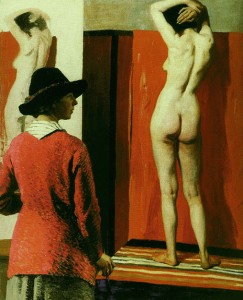
The National Portrait Gallery does not share this image on its website, so I found it here.
The portrait I chose in the National Portrait Gallery is “Self with Nude,” painted by Dame Laura Knight in 1913. This painting, illustrated above, is of a woman, the artist Laura Knight, painting a portrait of a nude female model. I found it striking as it was displayed in a large alcove, and its provocative nature most definitely caught my eye as it hung amongst other smaller, less distinctive portraits. Dame Laura Knight was an Official War Artist during the Great War (WWI) and recorded the famous Nuremberg Trials after WWII. In regards to this particular portrait though, it represents Knight’s prominence as a talented female painter defending the right for women to paint from a nude life model. The painting was placed in the gallery titled “We are making a New World Britain 1914-1918” where the gallery’s description stated that the Great War was an “end to an era, but it was also a catalyst for changes.”
Tags: 2010 Mary · Museums
[kml_flashembed movie="http://www.youtube.com/v/nZBtfNL7dP4" width="425" height="350" wmode="transparent" /]
Video on YouTube
After we got off the Tube at Covent Garden, we were a little disorientd so we asked a somewhat friendly-looking woman on the street for directions. In an eominous harbinger of our afternoon to come, she responded- in a dead flat American Midwestern accent- “Oh, I have no idea, it’s my first time here, too.” We soon realized the market was located just down the street. Within five minutes of entering, we found what the market was really about: a place for tourists and middle- and upper-middle-class locals to window shop and buy quasi-luxury items.
The first thing that surprised us about the market was the near total lack of ethnic food vendors. We actually only saw one food vendor, a fruit cart, despite the title Apple Market above the carts. Items for sale included handbags, jewelry, soaps, and other window shopping items. All of these were conspicuously advertised as “handmade,” creating a sense of authenticity for shoppers. Several of the vendors also sold paintings of the more traditional parts of London; items specifically for tourists. One vendor even had posters of American stars (i.e. Audrey Hepburn and Marilyn Monroe). These particular actresses are icons of higher class, which we felt reflected the classes that the market meant to attract. The area seemed to contain a lot of nouveaux rich items that would appeal to the middle- and upper-middle classes, as Fox suggests in Watching the English. The area seemed mostly designed for window shopping and watching free entertainment.
One of the entertainers, a melodramatic unicyclist, performed in front of St. Paul’s Church. There were two homeless men on the steps that most people seemed to be ignoring. The other historical area near the site was the Royal Opera House. To add to the artistic atmosphere, flags and various paintings hung along the market’s rafters.
We were surprised to find that most of the people in the area were white considering the amount of diversity in London. The people also seemed religiously neutral, compared to others we’ve seen elsewhere in London—we did not see any religious indicators, such as headscarves or yamoulkas.
The buzzword for the afternoon was definitely “homogeneity.” The market and its proprietors guarded the blandness of the place with extreme zeal. Ethnic restaurants (often chain restaurants) brandished flags with their countries of origin as if to make it obvious for tourists. A highlight of the unintentional comedy that this produced was a pub that hung a sign in the window saying: “Football colours are not permitted.”
The shops surrounding the market were equally lacking flavor. Many of the retailers were large American companies, such as: Oakley, Build-a-Bear, and Disney.
Amidst all this complaining about Covent Garden, it should be mentioned that the area felt extremely safe. We saw more young children in four hours today than we have seen in the fourty-eight hours we have been in London. The area was very family-friendly and also seemed to be a popular date spot for couples in their 30s and older. Also, the market was not totally soulless, as we had two fairly amusing encounters. First, we spotted a large group of men in rugby jerseys wearing obviously fake moustaches and Afro wigs. We felt compelled to ask them what drove them to do this, and the answer was that there was a rugby final at Wembley much later in the day. They came to the market to get drunk (although they seemed pretty well-behaved and claimed that they were neutral in support). Second, one of us gave in to the entreaties of a very haggard street salesman (wearing a lanyard with a card that said “WORKING, NOT BEGGING.” The card was not as unnecessary as it sounds) and bought a magazine from him. As he was clearly doing very poor business, we didn’t feel that bad chatting him up for ten minutes or so, a conversation dotted with some spectacular moments. The most memorable line was “You’re from the States then? You have Christmas, we have Christmas. But I have one big question: What the fuck is up with Thanksgiving? Seems like a bit of fraud to me.”
Tags: 2010 Dennis · 2010 Jesse · 2010 Mary · Markets
August 26th, 2010 · 1 Comment
To get to Liverpool Street Station we took the Tube Circle Line from Euston Square Station directly to Liverpool Street Station. We arrived there about nineteen minutes after departure. We walked north from the Arran House Hotel on Gower to the end of the street where the Euston Square Tube Station was located. We briefly confronted some difficulties with figuring out how to use the Oyster Card, but quickly learned how to properly swipe the card. We found the Euston Square Tube station to be quite pleasant as classical music echoed off cement walls, and most other riders were quite reserved. The Liverpool Street Station, we learned, was named after the street upon which it lies, which in turn is named after the former British Prime Minister Lord Liverpool.
At Liverpool St. station, we surfaced to a very busy market full of food, clothing, and other types of stores within a beautifully designed old railway station. The architectural design of the station featured intricate steel beams supporting a glass, vaulted ceiling. The people within the station were a mix of those formally dressed in suits and dresses and those in more casual attire. People were either moving in a quite hurried manner or were impatiently waiting, giving off a vibe of stress. Outside, the station was surrounded by new and incredibly tall financial buildings, many of which were still under construction. However located nearby were also many stores, restaurants, pubs, and residencies subscribing to various architectural styles, though most were outdated. We suspect many people would travel to this area for the shopping, restaurants, and blossoming financial sector for their work, reflected in the diversity of garb. This station is located within the realm of the City of London. It serves as a important link to various other parts of England.
The monument located outside the Liverpool Street Station is a memorial to Jewish children escaping Nazi genocide via trains coming into London through this very station, once named the Great Eastern Railway. In 1938 and 1939 over 10,000 Jewish children escaped Nazi persecution with the help of English citizens. We also found a plaque located nearby dedicating the entire Hope Square to these children.
To return to the Arran House Hotel, we chose a different route on the Tube. We took the Central Line from Liverpool Street Station to Tottenham Court Road. We then took the Northern Line north to Warren Street Station. Upon exiting the Tube station, we then walked down Gower Street to the hotel.
Tags: 2010 ChristopherB · 2010 Mary




















